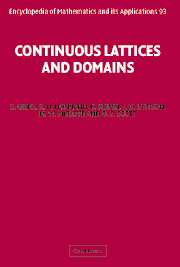Book contents
- Frontmatter
- Contents
- Preface
- Acknowledgments
- Foreword to A Compendium of Continuous Lattices
- Introduction to A Compendium of Continuous Lattices
- O A Primer on Ordered Sets and Lattices
- I Order Theory of Domains
- II The Scott Topology
- III The Lawson Topology
- IV Morphisms and Functors
- V Spectral Theory of Continuous Lattices
- VI Compact Posets and Semilattices
- VII Topological Algebra and Lattice Theory: Applications
- Bibliography
- List of Symbols
- List of Categories
- Index
III - The Lawson Topology
Published online by Cambridge University Press: 13 August 2009
- Frontmatter
- Contents
- Preface
- Acknowledgments
- Foreword to A Compendium of Continuous Lattices
- Introduction to A Compendium of Continuous Lattices
- O A Primer on Ordered Sets and Lattices
- I Order Theory of Domains
- II The Scott Topology
- III The Lawson Topology
- IV Morphisms and Functors
- V Spectral Theory of Continuous Lattices
- VI Compact Posets and Semilattices
- VII Topological Algebra and Lattice Theory: Applications
- Bibliography
- List of Symbols
- List of Categories
- Index
Summary
The first topologies defined on a lattice directly from the lattice ordering (that is, Birkhoff's order topology and Frink's interval topology) involved “symmetrical” definitions – the topologies assigned to L and to Lop were identical. A guiding example was always the unit interval of real numbers in its natural order, which is of course a highly symmetrical lattice. The initial interest was in such questions as which lattices became compact and/or Hausdorff in these topologies. The Scott topology stands in strong contrast to such an approach. Indeed it is a “unidirectional” topology, since, for example, all the open sets are always upper sets; thus, for nontrivial lattices, the T0 separation axiom is the strongest it satisfies. Nevertheless, we saw in Chapter II that the Scott topology provides many links between domains and general topology in such classical areas as the theory of semicontinuous functions and in the study of lattices of closed (compact, convex) sets (ideals) in many familiar structures.
In this chapter we introduce a new topology, called the Lawson topology, which is crucial in linking continuous lattices and domains to topological algebra. Its definition is more in the spirit of the interval and order topologies, and indeed it may be viewed as a mixture of the two. However, it remains asymmetrical – the Lawson topologies on L and Lop need not agree. But, even if one is seeking an appropriate Hausdorff topology for continuous lattices, this asymmetry is not at all surprising in view of the examples we have developed.
- Type
- Chapter
- Information
- Continuous Lattices and Domains , pp. 208 - 263Publisher: Cambridge University PressPrint publication year: 2003
- 1
- Cited by

